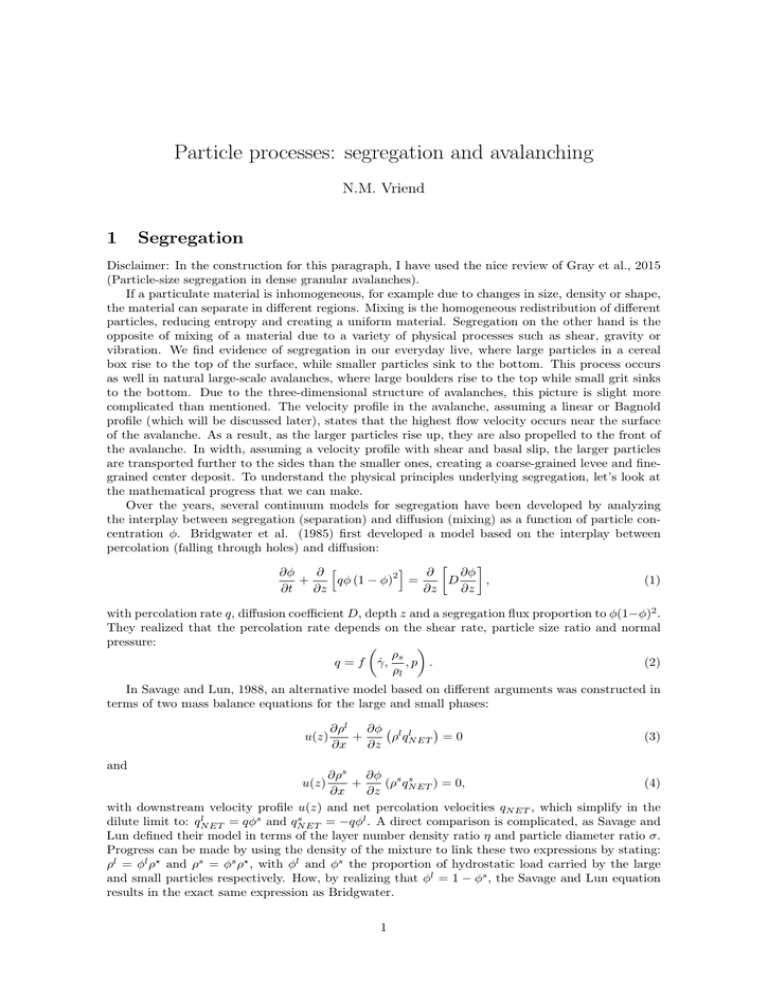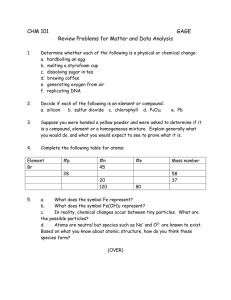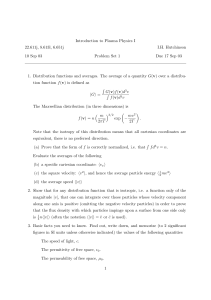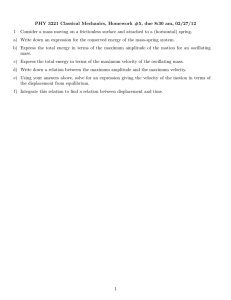Handout on Segregation and Rheology
advertisement

Particle processes: segregation and avalanching N.M. Vriend 1 Segregation Disclaimer: In the construction for this paragraph, I have used the nice review of Gray et al., 2015 (Particle-size segregation in dense granular avalanches). If a particulate material is inhomogeneous, for example due to changes in size, density or shape, the material can separate in different regions. Mixing is the homogeneous redistribution of different particles, reducing entropy and creating a uniform material. Segregation on the other hand is the opposite of mixing of a material due to a variety of physical processes such as shear, gravity or vibration. We find evidence of segregation in our everyday live, where large particles in a cereal box rise to the top of the surface, while smaller particles sink to the bottom. This process occurs as well in natural large-scale avalanches, where large boulders rise to the top while small grit sinks to the bottom. Due to the three-dimensional structure of avalanches, this picture is slight more complicated than mentioned. The velocity profile in the avalanche, assuming a linear or Bagnold profile (which will be discussed later), states that the highest flow velocity occurs near the surface of the avalanche. As a result, as the larger particles rise up, they are also propelled to the front of the avalanche. In width, assuming a velocity profile with shear and basal slip, the larger particles are transported further to the sides than the smaller ones, creating a coarse-grained levee and finegrained center deposit. To understand the physical principles underlying segregation, let’s look at the mathematical progress that we can make. Over the years, several continuum models for segregation have been developed by analyzing the interplay between segregation (separation) and diffusion (mixing) as a function of particle concentration ϕ. Bridgwater et al. (1985) first developed a model based on the interplay between percolation (falling through holes) and diffusion: [ ] ] ∂ϕ ∂ [ ∂ ∂ϕ 2 + qϕ (1 − ϕ) = D , (1) ∂t ∂z ∂z ∂z with percolation rate q, diffusion coefficient D, depth z and a segregation flux proportion to ϕ(1−ϕ)2 . They realized that the percolation rate depends on the shear rate, particle size ratio and normal pressure: ( ) ρs q = f γ̇, , p . (2) ρl In Savage and Lun, 1988, an alternative model based on different arguments was constructed in terms of two mass balance equations for the large and small phases: u(z) ) ∂ρl ∂ϕ ( l l + ρ qN ET = 0 ∂x ∂z and (3) ∂ϕ s s ∂ρs + (ρ qN ET ) = 0, (4) ∂x ∂z with downstream velocity profile u(z) and net percolation velocities qN ET , which simplify in the l s s l dilute limit to: qN ET = qϕ and qN ET = −qϕ . A direct comparison is complicated, as Savage and Lun defined their model in terms of the layer number density ratio η and particle diameter ratio σ. Progress can be made by using the density of the mixture to link these two expressions by stating: ρl = ϕl ρ⋆ and ρs = ϕs ρ⋆ , with ϕl and ϕs the proportion of hydrostatic load carried by the large and small particles respectively. How, by realizing that ϕl = 1 − ϕs , the Savage and Lun equation results in the exact same expression as Bridgwater. u(z) 1 Recently, Gray and Ancey, 2009 conducted a rigorous derivation of the general segregation equation for bidisperse mixtures based on first principles. The segregation for small particles states: [ ] ∂ϕs ∂ ∂ ∂ϕ + ∇ · [ϕs u] − [Sϕs (1 − ϕs )] = D , (5) ∂t ∂z ∂z ∂z with segregation velocity S, diffusivity D and the bulk 3D velocity field u which may be determined by the µ(I)-rheology. The segregation flux is zero in case of no small or no large particles (which makes physical sense). Recent work (e.g. Gajjar and Gray) indicate that the segregation flux may not be symmetrical, as larger particles rise slower through a matrix of smaller particles than the reverse. As a result, the quadratic flux function F (ϕs ) = ϕs (1 − ϕs ) could be replaced by a cubic flux function: F (ϕs ) = Aϕs (1 − ϕs ) (1 − γϕs ) , (6) with γ = 0.46 as suggested in Wiederseiner et al., 2011. The cubic flux function can also explain that a cluster of large particles rise up quicker through a matrix of small particles than a single large particle. The segregation Peclet-number P e = S/D is the ratio between advective and diffusive transport processes and may be used to quantify the importance of both terms. Diffusion will be important for small particle differences and on steep slopes, but progress can be made by assuming high Peclet-numbers such that the diffusion is essentially zero. The segregation equation than simplifies to: ∂ϕs ∂ + ∇ · [ϕs u] − [SF (ϕs )] = 0. (7) ∂t ∂z In this limit, it is possible to use the method of characteristics to construct 2D steady-state or timedependent solutions which feature shocks and expansion fans (similar to shocks in settling that we observed before). As particle phases invert due to segregation, hence large particles rise and small particles fall in time and/or distance, the packing fraction of particles may change, potentially drastically, as well. This is nicely illustrated in the example sheet where particle packings are analyzed for different combinations of particles. For bidisperse mixtures, the size segregation equation can be solved using a depth-averaged segregation model, similar to the depth-averaged velocity assumptions we made earlier in the course. As a result, we will need to depth-averaged the segregation equation, resulting in the following expression: ∂hϕ¯s ∂ + hϕ¯s u = 0, (8) ∂t ∂x with avalanche thickness h, depth-averaged concentration of small particles ϕ¯s and depth-integrated flux of small particles ϕ¯s u. Assuming a sharply inversely graded avalanche (ϕs = 0 for 0 < z < η) and a linear downslope velocity: u = αū + 2(1 − α)ūz/h, result in hϕ¯s = η and hϕ¯s u = ηū − (1 − α)ūη(1 − η/h) and: ] ∂ ¯s ∂ [ ∂hϕ¯s + hϕ ū − (1 − α)hūϕ¯s (1 − ϕ¯s ) = 0. (9) ∂t ∂x ∂x This depth-averaged equation is very similar to the full segregation equation which we analyzed before. The term ϕ¯s (1 − ϕ¯s indicates that the depth-averaged equation also separates particles, but this time not to the surface of the flow (in z-direction), but to the front of the flow (in x-direction). 2 Velocity profiles in avalanches A rheology describes the stress-strain relationship in terms of frictional parameters. In granular flows, the rheological behavior depends strongly on the phase of the material (solid, liquid or gaslike) and as such is not uniquely defined. Recent progress (e.g. Jop et al., JFM, 2005) resulted in the construction of a so-called µ(I)-rheology for the liquid-like behavior of granular flows. In the dense inertial regime, the shear stress and pressure are related as: τ = µ(I), P 2 (10) with the inertial number I, representing the ratio between the microscopic (rearrangement) and macroscopic (deformation) timescale: ˙ γd (11) I=√ . P ρ For both the plane shear and the inclined-plane geometry, the stress distribution is constant, hence P = constant and Pτ = constant. As a result, the inertial number I needs to be constant and equal to: τ I = µ−1 ( ). (12) P In plane shear at low inertia numbers or on the inclined-plane geometry for thin flows, the shear rate is uniform γ̇(z) = γ̇ and the velocity profile is linear with depth z: V (z) = γ̇z (13) In the case of deeper surface flows, for example on an inclined-plane geometry, the velocity V (z) as a function of depth z needs to be integrated: ∫ h V (z) = γ̇(z)dz, (14) 0 and the stress distribution is: P = ρg (h − z) cos(θ), (15) with τ = tan(θ). (16) P Now, the shear rate, from the equation with the inertial number, is: √ 1 P (z) −1 1√ γ̇(z) = µ (tan(θ)) = g (h − z) cos(θ)µ−1 (tan(θ)). (17) d ρ d √ Integrating this once over the height of the flow, and scaling with the factor gd, gives the velocity profile as a function of z: [ ] 3/2 3/2 h − (h − z) V (z) √ = A(θ) , (18) d3/2 gd with √ √ 2 2 A(θ) = µ−1 (tan(θ)) cos(θ) = I(θ) cos(θ). (19) 3 3 The velocity profile is in this case not linear, but scales with the depth as h3/2 and is called a “Bagnold velocity profile”. Analyzing the average velocity < V >, which can be interpretated as a depth-averaged velocity, can be achieved by: ( )3/2 ∫ h <V > 1 h V (z) 3 √ √ dz = A(θ) . (20) = h 0 5 d gd gd Rewriting this in terms of a Froude number F r gives: 3 h <V > = A(θ) . Fr = √ 5 d gh (21) By comparing this with the equation for the Froude number as derived from experiments and simulations: <V > h Fr = √ =α+β , (22) h gh stop (θ) and some functional similarities and scalings are observed. Assuming α = 0, which has been observed for experiments with smooth glass beads and simulations with spherical particles, one can derive an expression for β: 3 hstop (θ) β = A(θ) . (23) 5 d 3



